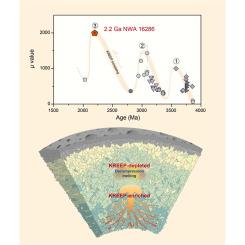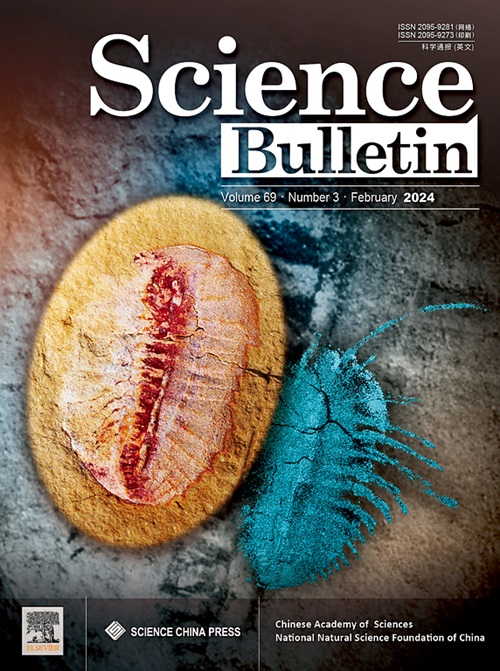2.2-billion-year-old KREEP-rich volcanism on the Moon
IF 21.1
1区 综合性期刊
Q1 MULTIDISCIPLINARY SCIENCES
引用次数: 0
Abstract
The Moon’s KREEP component—rich in potassium (K), rare earth elements (REE), and phosphorus (P)—is considered a critical heat source sustaining prolonged volcanic activity. However, Chang’e mission samples reveal a lack of KREEP signatures in the sources of mare basalt erupted ∼2.8 and 2.0 billion years ago, raising questions about its contribution to late-stage volcanism. Here, we present geochemical and geochronological analyses of the lunar basaltic meteorite NWA 16286, which crystallized 2201 ± 13 million years ago, representing the youngest known lunar meteorite. Its mantle source shows a high 238U/204Pb ratio (∼2000) and a low εNd(t) value (–4.3), indicating strong KREEP enrichment and extending the duration of KREEP-related magmatism by ∼800 million years. Compiled isotopic data from lunar basalts reveal three volcanic episodes, each characterized by progressively increasing 238U/204Pb and decreasing εNd, suggesting episodic mantle convection. We propose that episodic sluggish mantle overturn or plume-driven upwelling triggered initial decompression melting, followed by increasing incorporation of KREEP components into basalt sources during each episode of younger mare volcanism.

22亿年前月球上富含kreep的火山活动。
月球的KREEP成分富含钾(K)、稀土元素(REE)和磷(P),被认为是维持长期火山活动的关键热源。然而,嫦娥任务样本显示,在28亿年前和20亿年前喷发的海玄武岩来源中缺乏KREEP特征,这引发了对其对晚期火山作用的影响的质疑。在这里,我们对月球玄武岩陨石NWA 16286进行了地球化学和年代学分析,该陨石结晶于2201±1300万年前,是已知最年轻的月球陨石。地幔源238U/204Pb比值高(~ 2000),εNd(t)值低(~ 4.3),表明KREEP富集程度强,KREEP相关岩浆活动持续时间延长了~ 8亿年。月球玄武岩同位素数据显示,3个火山期均表现为238U/204Pb逐渐升高,εNd逐渐降低,表明存在幕式地幔对流。我们认为,幕式缓慢的地幔翻覆或羽流驱动的上升流触发了最初的减压融化,随后在每一段较年轻的海火山活动中,KREEP成分逐渐融入玄武岩源。
本文章由计算机程序翻译,如有差异,请以英文原文为准。
求助全文
约1分钟内获得全文
求助全文
来源期刊

Science Bulletin
MULTIDISCIPLINARY SCIENCES-
CiteScore
24.60
自引率
2.10%
发文量
8092
期刊介绍:
Science Bulletin (Sci. Bull., formerly known as Chinese Science Bulletin) is a multidisciplinary academic journal supervised by the Chinese Academy of Sciences (CAS) and co-sponsored by the CAS and the National Natural Science Foundation of China (NSFC). Sci. Bull. is a semi-monthly international journal publishing high-caliber peer-reviewed research on a broad range of natural sciences and high-tech fields on the basis of its originality, scientific significance and whether it is of general interest. In addition, we are committed to serving the scientific community with immediate, authoritative news and valuable insights into upcoming trends around the globe.
 求助内容:
求助内容: 应助结果提醒方式:
应助结果提醒方式:


